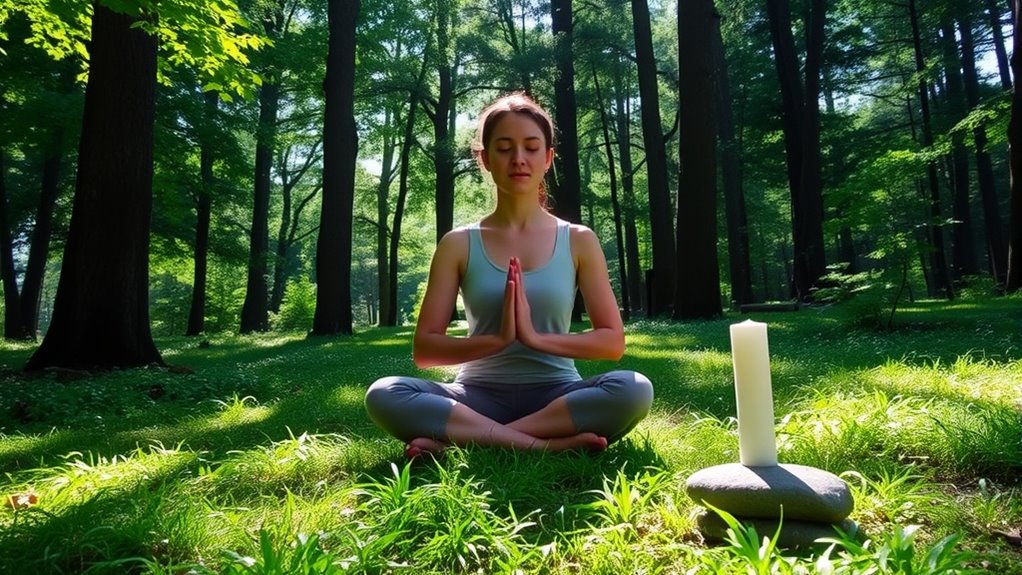Mindfulness practices can help you manage BPD symptoms by improving emotional regulation and reducing impulsivity. You can start by focusing on your breath, observing thoughts and feelings without judgment, and practicing regularly to strengthen your self-awareness. Techniques like mindful breathing, body scans, and pausing before reacting help create space between impulse and response. Incorporating these methods into your routine can promote stability and resilience—discover more ways to support your journey beyond this point.
Key Takeaways
- Engage in regular mindfulness exercises like mindful breathing, body scans, and observing thoughts to enhance emotional regulation.
- Practice pausing before impulsive actions, creating space to respond thoughtfully rather than react impulsively.
- Dedicate a few minutes daily to focused attention on present moment sensations, such as breath or sounds.
- Recognize and observe intense emotions without judgment to reduce reactivity and promote acceptance.
- Incorporate mindfulness into therapy, like DBT, to strengthen emotional control and decrease impulsivity in managing BPD symptoms.
Understanding the Role of Mindfulness in BPD

Understanding the role of mindfulness in BPD involves recognizing how it helps regulate intense emotions and impulsive behaviors. When you practice mindfulness, you learn to observe your thoughts and feelings without judgment, which reduces emotional reactivity. This awareness allows you to pause before acting impulsively, giving you space to respond thoughtfully rather than react automatically. Mindfulness also improves your focus on the present moment, helping you avoid ruminating on past mistakes or worrying about the future. As you develop greater self-awareness, you gain better control over emotional swings and self-destructive urges. This process strengthens your ability to manage the ups and downs of BPD, promoting stability and resilience. Ultimately, mindfulness becomes a crucial tool for cultivating emotional balance and reducing impulsive actions.
How Mindfulness Enhances Emotional Regulation

By practicing mindfulness, you learn to stay present and observe your emotions without judgment, which helps you respond instead of react impulsively. This awareness allows you to decenter from intense feelings, gaining perspective and reducing emotional overwhelm. As a result, you can manage your impulses more effectively, leading to greater emotional stability.
Cultivating Present Moment Awareness
Cultivating present moment awareness is central to how mindfulness enhances emotional regulation in individuals with BPD. When you focus on the here and now, you prevent past wounds or future anxieties from dominating your mind. This awareness allows you to observe your thoughts, feelings, and bodily sensations without judgment or reaction. By regularly practicing this skill, you develop a clearer understanding of your emotional triggers and patterns. Over time, you become better at recognizing early signs of intense emotions, giving you the opportunity to respond thoughtfully rather than impulsively. Present moment awareness creates space between stimulus and response, empowering you to manage emotions more effectively. This steady attentiveness fosters resilience, helping you navigate emotional turbulence with greater stability and control.
Decentering Emotional Responses
Decentering emotional responses allows you to observe your thoughts and feelings from a distance rather than being swept away by them. This perspective helps you detach from immediate reactions, creating space for clearer judgment. When you practice decentering, you recognize emotions as passing events, not defining aspects of yourself. This reduces impulsivity and emotional reactivity, fostering better regulation. You learn to view intense feelings with curiosity rather than judgment, which diminishes their power over you.
| Skill | Benefit |
|---|---|
| Observing thoughts | Reduces automatic emotional reactions |
| Nonjudgmental awareness | Cultivates acceptance of difficult feelings |
| Cognitive distancing | Enhances clarity and emotional control |
Reducing Impulsivity Effectively
Mindfulness considerably enhances emotional regulation by helping you recognize and pause impulsive urges before acting on them. When you practice mindfulness, you become more aware of your impulses as they arise, giving you the opportunity to choose a thoughtful response instead of reacting impulsively. This awareness strengthens your ability to resist immediate urges and reduces reckless behaviors.
To effectively reduce impulsivity, focus on:
- Observing urges without judgment – acknowledging impulses without immediately acting on them.
- Practicing deep breathing – calming your nervous system before responding.
- Pausing intentionally – creating space between impulse and action.
- Refocusing on the present – grounding yourself in the current moment to prevent emotional reactivity.
These steps help you regain control and foster healthier emotional responses.
Key Mindfulness Techniques for BPD Management

One of the most effective ways to manage BPD symptoms is through specific mindfulness techniques that foster emotional regulation and reduce impulsivity. A core practice is mindful breathing, where you focus on each inhale and exhale, grounding you in the present moment. Body scans help you become aware of physical sensations, allowing you to notice tension or discomfort without judgment. Observing thoughts and emotions as passing events—without attaching labels—encourages decentering, reducing overreactivity. Mindful listening sharpens your attention during interpersonal interactions, minimizing misunderstandings. Incorporating these techniques consistently strengthens your cognitive control, helping you navigate intense emotions more effectively and decrease impulsive behaviors. Regular practice makes mindfulness an integral part of your emotional regulation toolkit.
Benefits of Incorporating Mindfulness Into Treatment

Incorporating mindfulness into your treatment can help you better manage intense emotions and mood swings. It also encourages greater self-awareness, making it easier to recognize and respond to triggers. As a result, you may find it easier to control impulsive behaviors and build resilience over time.
Enhances Emotional Regulation
Practicing mindfulness can substantially improve emotional regulation for individuals with BPD by helping you manage intense emotions more effectively. It teaches you to observe your feelings without judgment, creating space between stimulus and response. This skill reduces emotional reactivity and stabilizes mood swings. Incorporating mindfulness offers these benefits:
- Increases awareness of emotional triggers, enabling early response.
- Strengthens cognitive control, helping you choose healthier reactions.
- Reduces emotional flooding, preventing overwhelm during intense moments.
- Fosters acceptance, allowing you to process emotions without self-criticism.
Reduces Impulsive Behaviors
Building on improved emotional regulation, mindfulness can also markedly reduce impulsive behaviors common in individuals with BPD. When you practice mindfulness, you become more aware of your thoughts, feelings, and urges before acting on them. This awareness creates a pause, giving you the opportunity to choose a more considered response instead of reacting impulsively. By focusing on the present moment, you learn to observe impulses without immediately acting on them, which weakens their intensity over time. Regular mindfulness practice strengthens your cognitive control, helping you recognize triggers earlier and respond more thoughtfully. As a result, you’ll find it easier to resist self-destructive urges, make safer choices, and build healthier coping strategies. Over time, this process fosters greater self-control and reduces impulsivity’s disruptive impact on your life.
Boosts Self-Awareness
Have you ever noticed how mindfulness helps you see your thoughts and emotions more clearly? When you practice regularly, you become more aware of your inner experiences without judgment. This heightened self-awareness allows you to recognize patterns, triggers, and reactions that previously went unnoticed.
Here are four ways mindfulness boosts self-awareness:
- It helps you identify emotional shifts before they escalate.
- You gain clarity on your thoughts and beliefs shaping your behavior.
- It encourages honest acceptance of both strengths and vulnerabilities.
- You develop a more accurate sense of self, reducing preoccupations and distortions.
Practical Steps to Cultivate Mindfulness Daily

To effectively incorporate mindfulness into your daily routine, start by setting aside a dedicated time each day for practice. Choose a quiet moment, whether morning, lunch break, or evening, when you won’t be disturbed. Begin with just five minutes, focusing on your breath or bodily sensations. Use a simple routine, like paying close attention to each inhale and exhale or observing sounds around you without judgment. Keep your attention gentle and nonreactive, gently bringing it back whenever it wanders. Gradually increase your practice time as you feel more comfortable. Consistency is key, so aim to practice daily, even if only for a few minutes. Over time, this regular effort builds your mindfulness skills, helping you manage BPD symptoms more effectively.
Evidence Supporting Mindfulness-Based Interventions

Numerous studies and systematic reviews provide evidence that mindfulness-based interventions can considerably improve emotional regulation and reduce impulsivity in individuals with BPD. These findings support integrating mindfulness into treatment plans. Here are key insights:
Research shows mindfulness significantly improves emotional control and reduces impulsivity in BPD treatment.
- They enhance attention control, helping you stay present instead of being overwhelmed by emotions.
- Mindfulness promotes decentering, allowing you to observe thoughts without judgment and gain perspective.
- Research shows improvements in impulsivity, leading to fewer self-destructive behaviors.
- Combining mindfulness with therapies like DBT amplifies emotional regulation skills and resilience.
While promising, larger clinical trials are needed to confirm long-term benefits. Still, evidence indicates mindfulness is a valuable component for managing BPD symptoms effectively.
Future Opportunities for Mindfulness in BPD Care

Advancements in research and clinical practice present promising opportunities to expand the role of mindfulness in BPD care. As you explore new treatment avenues, integrating mindfulness more deeply into existing therapies like Dialectical Behavior Therapy (DBT) could enhance outcomes. Emerging neuroscientific studies may reveal how mindfulness induces brain changes that improve emotional regulation and impulse control, offering targeted intervention strategies. Additionally, developing tailored mindfulness programs for specific BPD symptoms, such as self-harm or interpersonal difficulties, could increase effectiveness. Larger clinical trials will help solidify mindfulness as a standard component of treatment, making it more accessible and adaptable. By embracing these opportunities, you can contribute to evolving BPD care that emphasizes resilience, self-awareness, and emotional stability through innovative mindfulness applications.
Frequently Asked Questions
How Long Does It Take to See Benefits From Mindfulness for BPD?
You might start noticing benefits from mindfulness within a few weeks, especially if you practice regularly. Many people see improvements in emotional regulation, impulsivity, and self-awareness after about 8 to 12 weeks of consistent practice. Keep in mind, progress varies depending on your dedication and the type of mindfulness techniques you use. Staying persistent and integrating mindfulness into your daily routine can help you experience positive changes sooner.
Can Mindfulness Replace Other BPD Treatments Like Therapy or Medication?
Mindfulness can’t fully replace treatments like therapy or medication for BPD, but it can substantially complement them. You should see mindfulness as an additional tool to improve emotional regulation, reduce impulsivity, and enhance self-awareness. Combining mindfulness with therapies like DBT or appropriate medication offers the best chance for managing symptoms effectively. Always consult your healthcare provider to develop a thorough treatment plan tailored to your needs.
Are There Risks or Drawbacks to Practicing Mindfulness With BPD?
Practicing mindfulness with BPD can sometimes lead to increased awareness of difficult emotions, which might feel overwhelming or triggering initially. If you’re not guided properly, it could result in feelings of frustration or emotional destabilization. It’s essential to approach mindfulness gradually, ideally with professional support, to avoid these risks. Remember, mindfulness should complement other treatments and not replace professional therapy or medication without medical advice.
What Age Is Appropriate to Start Mindfulness Practices for BPD?
You can start mindfulness practices as early as adolescence, which is around age 12 or 13. Research shows that early intervention helps improve emotional regulation and reduces impulsivity in teens with BPD traits. If you’re a parent or caregiver, introducing age-appropriate mindfulness activities can foster self-awareness and resilience. Just make certain the practices are tailored to the individual’s developmental level, making them accessible and engaging to promote long-term benefits.
How Do Cultural Differences Influence Mindfulness Practices in BPD Treatment?
Cultural differences shape how you approach mindfulness in BPD treatment by influencing your beliefs, values, and comfort levels with specific practices. You might find certain meditation styles or spiritual elements more relatable or acceptable based on your background. Incorporating culturally relevant traditions can enhance your engagement and effectiveness. Adapting mindfulness techniques to respect your cultural context helps you feel more connected and open to benefits like emotional regulation and resilience.
Conclusion
By weaving mindfulness into your daily life, you’ll plant seeds of calm amidst life’s stormy seas. Like a steady lighthouse guiding a ship through turbulent waters, these practices illuminate a path toward emotional balance and resilience. Embrace each moment with gentle awareness, allowing mindfulness to become your compass. With patience and persistence, you’ll transform chaos into clarity, forging a tranquil haven within that guides you safely through the waves of BPD.








